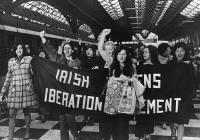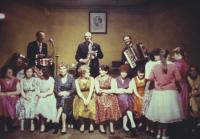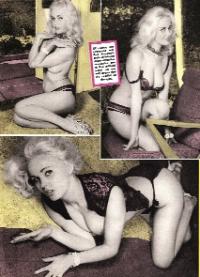Ask Angela: reappraising the Irish ‘sexual repression’ narrative
Published in 20th Century Social Perspectives, 20th-century / Contemporary History, Features, Issue 2(March/April 2012), Volume 20
Supporters of the Irish Women’s Liberation Movement’s ‘contraception train’ arrive at Dublin’s Connolly Station in May 1971. The feminist movement had emboldened women to reject their appraisal at the dancehall and to demand an increased sexual component on dates and in relationships prior to marriage. (Eddie Kelly/Irish Times)
The history of the sexuality of Ireland reveals the nation to be something of an oddity. No history is complete without reference to the range of demographic characteristics that set us apart. In 1966, for example, Ireland had the lowest marriage rate in Europe, yet it had the highest marital fertility rate. The percentage of the population that never married was the highest in the Western world. Repressive legislation governed contraception, homosexuality and the publication and screening of material deemed too explicit by a political and religious establishment fearful that the walls keeping out a British and European moral contagion would break. The archbishop of Cashel and Emly, Dr Morris, described Ireland in 1961 as a Christian country surrounded by paganism. The Irish were different. The landmark ethnographic studies of family life by luminaries like Arensberg and Kimball confirmed this—that the Irish, in Scheper Hughes’s words, were ‘troubled by sexuality’. It appeared that a unique constellation of religious, familial and political influences had determined the sexual character of the nation. The Irish would carry this unflattering legacy for generations, believing that they were more sexually inept, repressed and guilt-ridden than our more sexually enlightened European neighbours.
Accessing the ‘sexual revolution’ elsewhere
Much commentary identifies how Ireland ‘missed’ the sexual revolution of the 1960s. This places Ireland in the category of a late moderniser struggling to catch up, or a country waiting to be transformed by externally led modernising influences. In Britain, for example, a series of legislative measures such as the 1967 abortion act or the decriminalisation of homosexuality in the same year confirmed a nation in the midst of a sexual revolution. Or did it? Despite this legislative reform agenda, how people experienced sexuality at a local, everyday level in their communities and family homes told a somewhat different story. Diarmaid Ferriter questions the extent to which the sexual revolution had an impact beyond London and the south-east of England. Historian Jeffrey Weeks also points out that British sexual behaviour had remained remarkably chaste, with births outside marriage rising modestly from 5% in 1955 to 8% in 1967. Surveys of sexual attitudes, like the Latey Committee during the 1960s, also pointed to a high degree of conservatism among British youth, with the majority declaring that they wanted to marry virgins and would marry a girlfriend if she became pregnant. More in-depth research in Britain supports the argument that the experience of married couples struggling to regulate their family size owing to limited access to contraception was not dissimilar to the situation facing Irish couples. A study by Dennis et al. of Yorkshire mining communities revealed how women were often confronted by a lack of access or willingness on the part of their husbands to use contraception. One woman interviewed, described by the authors as a woman aged beyond her years after multiple miscarriages, told how she had bought condoms in the chemist but her husband threw them into the fire, stating that they took ‘all the enjoyment out of sex’. Joanna Bourke’s study of working-class British communities also revealed a similarity to Irish women in their difficulty in acquiring information about contraception. In the late 1950s the Medical Women’s Federation wrote that only four out of 27 medical schools provided undergraduates with lectures on contraception. Letters to Marie Stopes reviewed by Bourke show how sexual abstinence was a key method of family planning exercised by women in the 1960s as the opening of birth control clinics was unevenly distributed throughout the country. The letters reveal that the most common form of family planning after abstinence was abortion, made safer after the passage of the 1967 act. The situation in other European countries was not dissimilar, with France not repealing a ban on contraception until 1967. Mary Evan’s book on love describes her attempts to check into what she describes as a large international hotel chain in Madrid in 1976 with her boyfriend, only to be quizzed by the receptionist as to their marital status. In the Netherlands, seen as the most sexually liberated of European countries, surveys reveal how sex between heterosexual couples remained traditional, with over 50% of Dutch men reporting an aversion to clitoral stimulation in the mid-1970s.A review of the letters sent to Angela Macnamara revealed that couples had experienced similar difficulties to those described in Britain. A letter published on 14 December 1975, for example, revealed how abstinence was also used as a family planning strategy:

Irish women patiently await the men in a 1950s rural dancehall—as depicted in Pat O’Connor’s Ballroom of Romance (1982). By the 1960s women were disconcerting men with a perceived sexual assertiveness in the dancehall and in the bedroom. (RTÉ Stills Library)
‘Q. I read about “self-control in marriage” recently in your column… we have four children inside these five years and we tried to space them using the safe period also the rhythm, all to no use. The babies still came… I decided there was only one way out for us “Catholic style”, to abstain from sexual intercourse. That was twelve years ago.’
While recognising that such a similar plight existed for couples, particularly women, in trying to regulate their families, this is only one story. The analysis of the letters (645 in total) and the interviews revealed alternative stories to the sexual repression narrative. Side by side with stories of couples struggling to communicate their desire for sexual intimacy, held back by inhibition or internalised guilt, were other stories of couples who often also struggled but showed a greater determination to utilise newly available resources to fashion more satisfying sex lives.
Telling an alternative sexual history
For many Irish Catholics who had heeded the message of self-restraint during their courtships, the honeymoon provided the opportunity for sex with a degree of privacy and legitimacy that previously had been denied. The letters to Macnamara reveal the honeymoon to have been an anxious time, with one woman writing on 10 July 1977 that her recently completed pre-marriage course said ‘very little about the honeymoon’. The men I interviewed also shared a similar anxiety but a realisation that their married sex life would be one of learning and sometimes mistakes. The oldest interviewee described little anxiety but thought that ‘anything you have to learn has awkward moments and you have to learn the mechanics of whatever it is, whether it is a bike or driving a car, you make mistakes and you have to go on learning’. Another also saw sex as something that could be learned and availed of the wider availability of sex manuals on his honeymoon:
‘I remember having a book lying on top of her telling us how to have sex … on our honeymoon in Paris. That’s the truth, it was a learning exercise for us both.’
Angela Macnamara, whilst an advocate of sex education, remained suspicious of sex manuals, particularly their use by men. On 28 October 1973 she advised a young man intending to marry and reading a manual that to ‘reread these passages for the purpose of making oneself aroused’ was not proper conduct for a man on the cusp of marriage. The realisation that sex was a central part of happily married life was increasingly discussed in the 1960s and ’70s. Articles, even in the conservative Sunday Press newspaper by journalist Gillie Kennealy, warned men particularly that the traditional ‘bang-bang’ attitude to sex, where every kiss or touch must lead to intercourse, was no longer acceptable to women. Both men and women were now more prepared to vocalise their sexual needs, to modify their expectations and adjust to the newly communicated wants of the other. One interviewee revealed that his wife rarely achieved orgasm through sexual intercourse and so the focus of their sex lives changed to oral sex, where orgasm for his wife was possible. When I asked him whether this shift towards oral sex was reciprocal he replied ‘that he thought it rude to ask’. Not all the men I spoke to were so quick to modify their sex lives: one told me, with regard to oral sex, that ‘he didn’t know it existed … [it] never crossed our minds’.Letters from both men and women to Macnamara’s column also revealed a desire to improve their sex lives. In a letter of 15 February 1976 a married woman in her mid-fifties asked whether it was too late to have a discussion with her husband about why she got so little pleasure from sex. Another woman in a letter of 13 April 1980 speculated whether ‘Irish men in this country know how to make love’, given her lack of sexual pleasure with her husband. While Macnamara consistently answered such letters in the belief that women hadn’t the right emotional context to enjoy sex, it ignored a more fundamental problem that often men, through accident or design, didn’t possess the physiological knowledge to pleasure their wives.

British 1960s glamour model Annette Johnson—the type of material deemed too explicit by a political and religious establishment fearful that the walls keeping out a British and European moral contagion would break. (Parade, 20 February 1965)
Women increasingly assertive
Women also disconcerted men with a perceived sexual assertiveness in the dancehall and the bedroom. Letters to the Macnamara column from men revealed that the feminist movement had emboldened women to reject their appraisal at the dancehall and to demand an increased sexual component on dates and in relationships prior to marriage. A man writing on 4 November 1973 thought that there was ‘hardly a girl that you would approach who wouldn’t go to bed with you’, while another published on 11 August 1974 thought that a lot of women ‘welcome, desire and encourage sexual experience before marriage’. Macnamara was conscious that the gender regime, so carefully preserved through the segregation of the sexes in schools, churches and social activities, was now out of alignment. She wrote on 4 July 1976 in a reply to a letter lamenting the growing sexual assertiveness of women that:
‘In all the current talk about women’s lib I think we very often forget to consider women’s strength and their consequent responsibilities. Once a woman sees herself as a “man hunter” she tends not only to lower her own dignity and the respect of men but also to encourage lowering the standards and sense of responsibility of men.’
Conclusion
The everyday intimate lives of men and women has been the focus of this research. The letters and stories call into question some carefully crafted dichotomies through which we have heretofore understood the sexual history of this period. They question the ‘sexual repression’ narrative but also the extent to which the 1960s/’70s is understood as a period of exaggerated social change. A more balanced appraisal of the period is called for that places Ireland in a wider international context, free from the stereotypes of the past, and that allows for a new sexual history to be written. The research reveals how some couples, rather than being passive recipients of Catholic social teaching, were active in adapting their emotional and sexual lives in the light of new information gleaned from a wider range of media available in Ireland. They were part of a wider debate that contributed to how men and women would increasingly disclose their mutual need for emotional and sexual intimacy. Many couples did enjoy good sexual relationships. And when they were less than satisfactory, some relied on this wider range of sexual discussion, including problem pages, to make them better. HI
Paul Ryan’s Asking Angela Macnamara: an intimate history of Irish lives was published by Irish Academic Press in 2011.
Further reading:
D. Ferriter, Occasions of sin: sex and society in modern Ireland (London, 2009).T. Inglis, Lessons in Irish sexuality (Dublin, 1998).
















